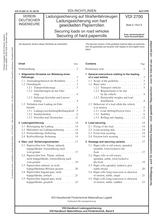
Technical rule [CURRENT]
VDI 2700 Blatt 9:2006-04
Securing loads on road vehicles - Securing of hard paperrolls
- German title
- Ladungssicherung auf Straßenfahrzeugen - Ladungssicherung von hart gewickelten Papierrollen
- Publication date
- 2006-04
- Original language
- German, English
- Pages
- 30
- Publication date
- 2006-04
- Original language
- German, English
- Pages
- 30
Product information on this site:
Quick delivery via download or delivery service
Buy securely with a credit card or pay upon receipt of invoice
All transactions are encrypted
Short description
This guideline describes examples of the securing of hard paper rolls to road vehicles as per Section 1.2, which are used for transporting paper rolls. It is meant for dispatchers, loaders, drivers, vehicle owners and those in charge of load securing and safe transport by operation of law or by virtue of an ordinance, a contract or a different set of rules. The fields of competence derive from the national regulations, the legal provisions and the corresponding laws and regulations of other countries, where cross-border freight transport on roads is concerned. The guideline is in accordance with the rules of technology valid at the time of drafting. Rail, sea, and air freight have been excepted from the present guideline's scope and will be included in other guidelines and standards. The same applies to intermodal transport to the extent as covered by special provisions such as the guideline VDI 2700 Part 7 or DIN EN 283 (Combined freight transport) or the load-securing rules of the Railways. The multitude of types of paper transported in the form of rolls and the great number of load-securing options and special vehicles cannot be considered to their full extent in this guideline. Load-securing methods which can be demonstrated to be equivalent or even more effective may therefore be used instead of those mentioned in this guideline. It must be ensured that the maximum inertial forces to be assumed for load securing with the vehicle in motion can be taken up. Forces acting in the course of accidents are not taken into account (see preliminary note). This guideline applies neither to the transport of palletised rolls, palletised size sheets or cut-to-size board or cardboard on pallets, nor to soft paper rolls (such as hygienic-paper mother rolls), waste-paper bales etc. Hard paper rolls are dealt with exclusively.
Content
ICS
55.180.99
Also available in
Loading recommended items...
Loading recommended items...
Loading recommended items...

